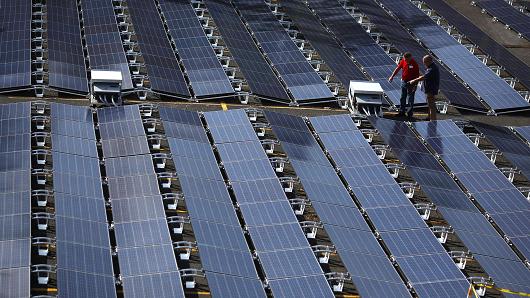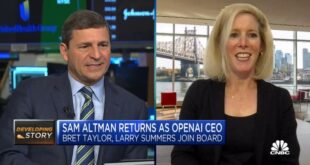
Alvin Baez | Reuters
Men gesture next to solar panels set up by Tesla, at the San Juan Children’s Hospital, after the island was hit by Hurricane Maria in September, in San Juan, Puerto Rico October 26, 2017.
One plank of Donald Trump’s election platform was centered on rebalancing the trade relationship between the U.S. and China.
He once told an interviewer that he preferred “fair trade” to plain old “free trade.” His Commerce Secretary Wilbur Ross has taken up that baton as a very public proponent of the so-called “America First” policy; he has strongly backed Boeing in a dispute with Canada’s Bombardier over subsidized pricing for its C-series jet program, and recently told a Davos audience that while there have always been trade wars, the situation today is different because “U.S. troops are now coming to the ramparts.”
As the World Economic Forum opened at Davos, in what may have been the opening salvo of a potential U.S.-China trade spat, the Trump administration announced it was applying a 30 percent tariff to certain imports, to include solar panels and modules. The White House framed the decision as one that provided “relief to U.S. manufacturers,” with U.S. Trade Representative Robert Lighthizer’s office claiming that artificially low-priced solar cells and modules from the world’s leading producer of solar products, China had caused “serious injury” to America’s domestic solar industry.
As ever, it is worth examining the back story to this decision, which will mean tariffs on imported solar cells and modules jump to 30 percent over the next year before gradually falling to 15 percent at the end of a four-year period. The administration’s argument is that the Chinese government has in the past subsidized solar manufacturers inside China, allowing them to sell products in the U.S. at less than their fair market value. When the U.S. authorities previously attempted to clamp down on this practice under former President Barack Obama, the Chinese firms simply started producing their solar panels and modules elsewhere. During Obama’s last term in office, the amount of solar power generating capacity that was installed each year across the United States tripled, imports quintupling and correspondingly prices — according to Lighthizer’s office — plummeted 60 percent. U.S. solar firms struggled to compete on price, and more than two dozen ended operations during that same period, so that 2017 saw just a handful of U.S. producers of solar cells and modules survive.
 EU News Digest Latest News & Updates
EU News Digest Latest News & Updates


